Don't get lost in this restaurant..
Friday, March 26, 2021
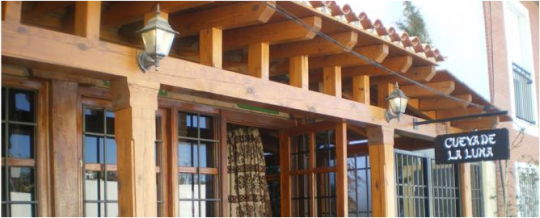
Don't go looking for the bathroom in Armando Rico's restaurant unless you have a real sense of adventure. In most restaurants, you may accidentally wander into the kitchen, or a broom closet in an attempt to relieve yourself. In this small restaurant in Titulcia, you may stumble upon a deep manmade cave with unknown origins and an allegedly powerful psychic energy.
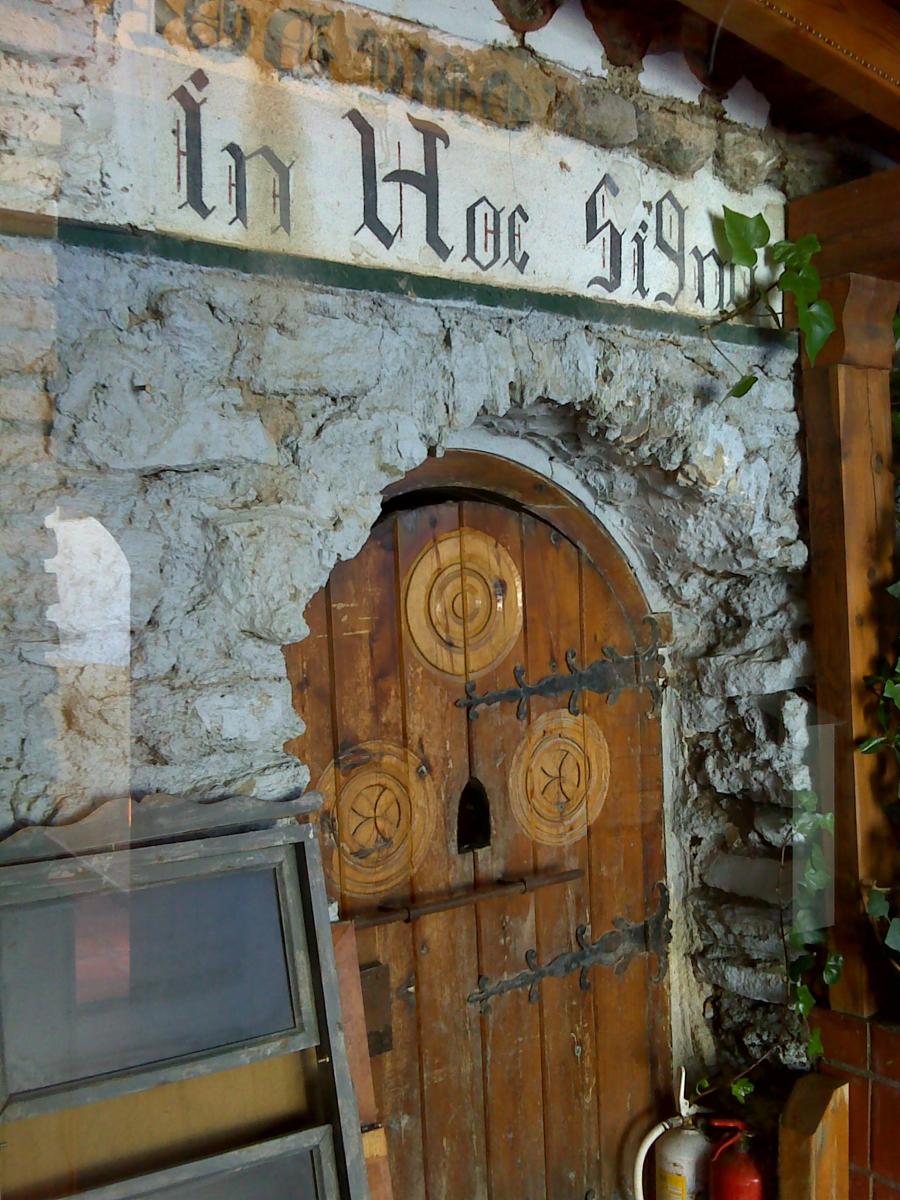
La Cueva de Luna, or Cave of the Moon, was discovered in 1952 by the restaurant owner Rico and his brother. With just a little digging, they discovered an entire underground world, complete with etched symbols, crosses and giant domed chapels. Although the archways and plastered walls seem to place the catacombs in the early Renaissance, the origins have remained a mystery since its discovery.
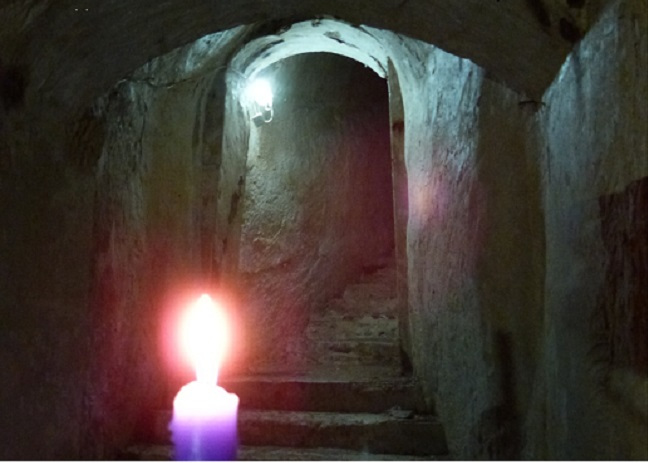
After descending into the catacombs, a series of domed chambers are interconnected below the earth by dark tunnels. With only candles available, light barely illuminates the buried deepness of the tunnels and offers only flickers of the strange symbols and crosses that bedeck the walls. Although there is a great deal of medieval art to analyze in La Cueva de Luna, the environment is hardly inviting to the average visitor.
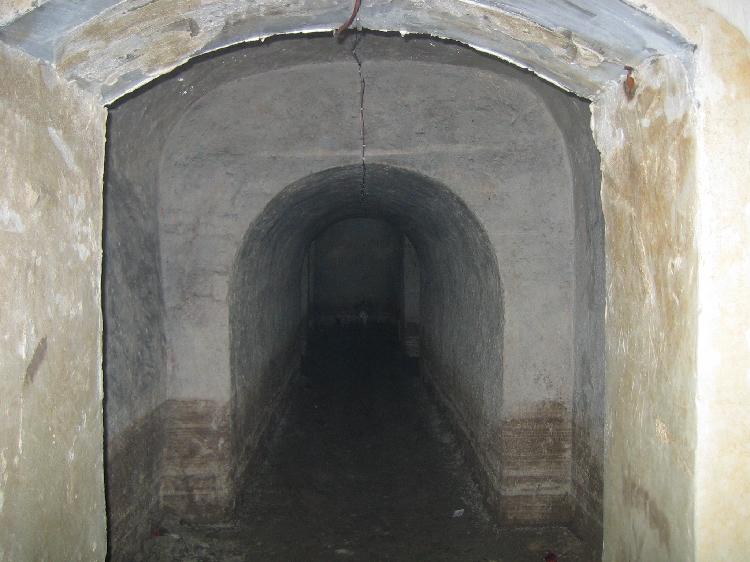
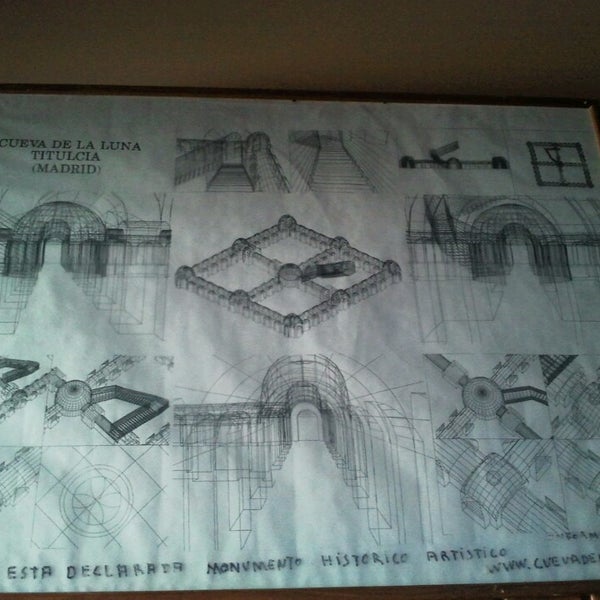
Little exploration and archaeology were done in the caves until the mid-1970s when researchers from Germany began to analyze the underground world. They concluded that the caves and tunnels were laid out in a cross pattern, and suggested that the Cueva de Luna was a meeting location for the Knights Templar, a controversial Catholic group tied closely to the Crusades in the 12th century.
Further confounding an explanation for the cave, were the remains of Celts, Romans and other medieval peoples, which could suggest the cave served a whole range of other utilities. Visitors have added their own theories to the cave, as many have remarked feeling an eerie sense of power while within the cave. Others still have reported feeling a great sense of terror.
Despite evidence suggesting a more unique origin, some simply believe the cave was a warehouse. However, without ventilation, and with clear religious markings on the walls, this theory has held little sway with those who see conspiracy in these Spanish tunnels' history. Rico has documented many of these theories in his own book on the cave, and with his permission, visitors can enter the cave through the back of his restaurant in Titulcia.
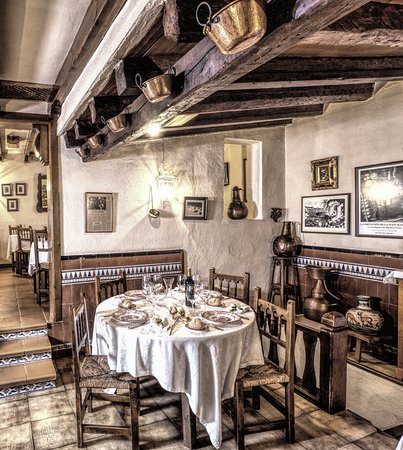
Ver mapa más grande
 3
Like
Published at 11:19 AM Comments (0)
3
Like
Published at 11:19 AM Comments (0)
The Origin of Sangria and how to make it
Thursday, March 18, 2021
If you thought that sangría was a Spanish invention, then think again. The “refreshing drink which combines wine and water with sugar and lemon and other complements”, as it is defined in the official Spanish dictionary(RAE), is British. Well, the name is... Yes, I was just as surprised when I found out!
The British sangría has been known about since 1987 when the philologist Francisco Marcos Álvarez, divulged to the Spanish Language History Congress (Cáceres) that the word sangría comes from 'sangaree', a drink enjoyed by the British residents of the British West Indies and some other North American colonies back in the seventeenth century. When British ex-pats are demanding sangría on the terrace of a local bar they are unwittingly using an Anglicism.
Sangaree, back in 1694 on the island of Martinique, was made with “Madeira wine mixed in a jug with sugar, the juice from a lemon, a little cinnamon and powdered clove, plenty of nutmeg and a crust of toast”. This drink was described by the Frenchman Jean-Baptiste Labat in his book 'Nouveau voyage aux isles de l'Amérique' (1722), who tasted the concoction on his trip to the British Antilles and declared that once strained and chilled, it was delicious and refreshing.
This 'sangaree', made with wine from Madeira, Porto or the Canary Islands (sometimes also with rum), was a very popular drink in the colonies of Barbados, Bahamas and Virginia throughout the seventeenth and eighteenth centuries. From the English 'sangaree', Labat understood 'sang-gris', a term that passed via Chinese whispers to Spanish as 'grey blood' thanks to Esteban Terreros and his 'Diccionario Castellano con las voces de ciencias y artes' (1788). He defined it as “a beverage that the English invented and is often drunk in the English and French colonies of America: the English say that it refreshes because it contains some lemon juice or citron [...] but that it goes quickly to the head proves that this drink contains a lot of spirit and a lot of fire”.
In 1803, the RAE would veto 'grey blood' and would choose to include a new meaning for the word sangría: “a drink that is composed of water, lemon and red wine”. This meaning stood for decades in Mexico and other Spanish-American countries, probably due to the Caribbean influence, but strangely in Spain, there is no previous mention to 1800, except for “sangrías de vino tinto” served at the Cadiz Carnival in 1770.
Is it that wine and lemon maybe didn't appeal to Spaniards? Of course it did, but until the beginning of the 19th century, that mixture was known here as lemonade. A descendant of the medicinal and spicy wines of the Middle Ages, wine lemonade was one of the most popular drinks of the Golden Age.
Whether served as a soft drink or as a medicine, it was used to treat fever, vomiting and as an anticoagulant measure before bloodletting. However, by the mid-nineteenth century, Spain fervently adopted the term 'sangría' and the old 'lemonade' was abandoned.
In Menorca, the sengri menorquin, without a doubt comes from the English 'sangaree'. The British occupation of the island during the seventeenth century left, among other things, this hot drink made from red wine, sugar, orange, cinnamon, anise, nutmeg and bread, extraordinarily similar to that concoction that over 300 years ago Labat tried in sunny Martinique.
With the passing of time Sangria developed into what we would now consider the 'traditional' recipe. Traditional homemade sangria is typically made with good young red wine and seasonal fruits, both in the form of juice (oranges, lemons) and in pieces to add flavour (peaches and apples). If you fancy making it here are the steps to follow:
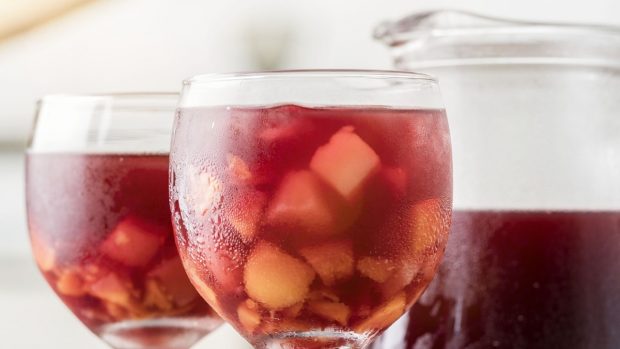
Ingredients to prepare homemade sangria (1.5 litres):
1 bottle of good red wine (750 ml) - 'Tinto Joven'
2 peaches
1 apple
2 oranges (variety for juice)
1 lemon for juice
1/2 cinnamon stick.
1 can (330 ml) soda (optional)
2 tablespoons of sugar.
2 tablespoons of water.
- Squeeze the oranges and the lemon, strain their juice and put it in the jug or container where you are going to serve the sangria. Also, add the red wine.
- Peel the apple, core it, cut it into small squares and add them to the jar.
- Do the same with the peaches: peel them, remove the pit, cut them into squares and put them in the jar as well and add the cinnamon stick.
- Now you will need to prepare a small syrup. It is simply a matter of diluting the sugar so that when it is added to the jar it dissolves perfectly and does not remain at the bottom. To do this, put the sugar and water in a saucepan over medium heat for a few minutes until the sugar dissolves. Add it to the jar and stir well.
- Now let it rest at room temperature for a couple of hours, so that the flavours merge and the wine absorbs all the flavour of the fruit. If you are going to drink it more than two hours after preparing it, then you should put it in the refrigerator until it is time to serve it.
- Just before serving, you can add the soda, if you want - it is optional. It is best to put ice in the glasses and not in the jug to avoid diluting it too much.
 2
Like
Published at 6:58 PM Comments (1)
2
Like
Published at 6:58 PM Comments (1)
On Top of the World
Friday, March 12, 2021
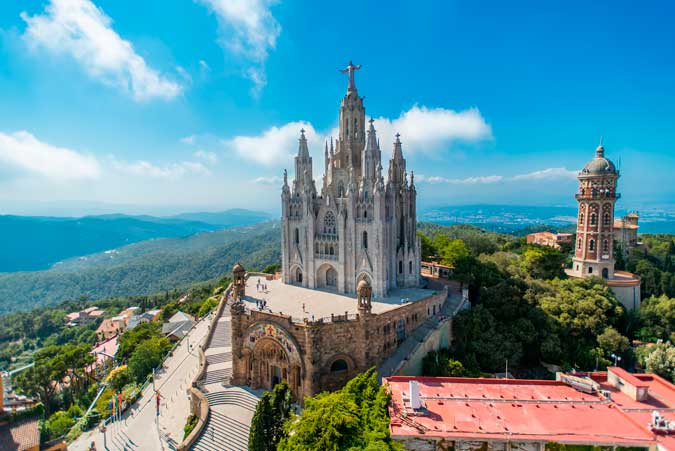
The idea of building a Catholic church on the summit of the Mount Tibidabo overlooking Barcelona emerged in the late 19th century amidst rumours about the construction of a Protestant church and a hotel-casino at that location. This motivated a "Board of Catholic Knights" to acquire the ownership of the field and give it to Saint John Bosco in 1886 when he was visiting Barcelona at the invitation of Dorotea de Chopitea, a great patron and promoter of the project.
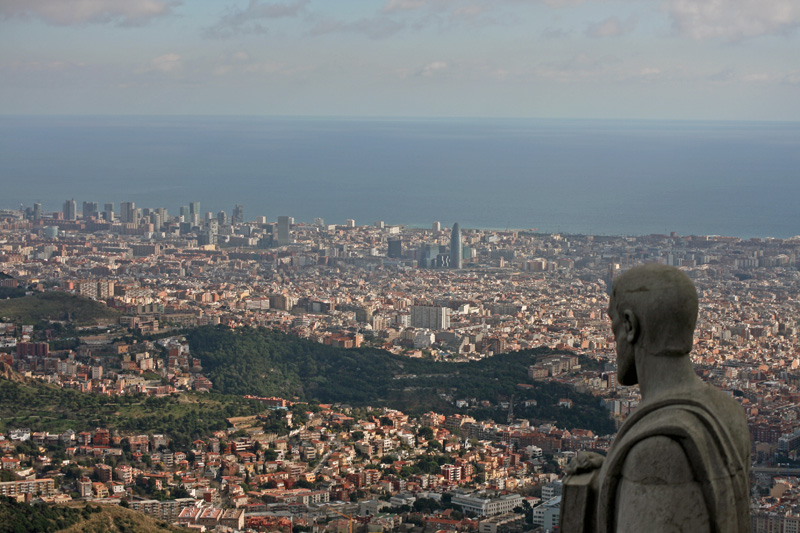
From this arose the idea of a building dedicated to the Sacred Heart of Jesus, a dedication very popular at that time thanks to the impetus given by Pope Leo XIII, and following in line with the church built in Rome by Bosco himself (Sacro Cuore di Gesù a Castro Pretorio) and the famous Sacré-Cœur in Paris.
In 1886 a neo-Gothic hermitage was built, and two years later, for the Universal Exposition, the Vallvidrera 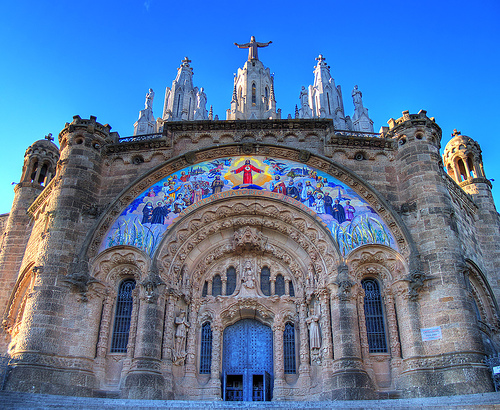 road was urbanised and a pavilion of Mudejar inspiration was built beside the hermitage to serve as a viewing point for the city below. However, the project to build the church suffered a significant delay mainly because of the development of a new project to build an astronomical observatory on the summit of Tibidabo, which was eventually constructed on a nearby hill - Fabra Observatory. road was urbanised and a pavilion of Mudejar inspiration was built beside the hermitage to serve as a viewing point for the city below. However, the project to build the church suffered a significant delay mainly because of the development of a new project to build an astronomical observatory on the summit of Tibidabo, which was eventually constructed on a nearby hill - Fabra Observatory.
Finally, on 28 December 1902, the first stone was placed in a ceremony presided by the Bishop of Barcelona, Salvador Casañas i Pagès. The crypt was built between 1903 and 1911, and the main church was built between 1915 and 1951. The church was consecrated by Bishop Gregorio Modrego Casaus during the 35th Eucharistic Congress held in Barcelona in 1952. The towers were completed afterwards, with work officially ending in 1961. On 29 October 1961, the church received the title of minor basilica from Pope John XXIII.
The external appearance of the church is of a Romanesque fortress of stone from Montjuïc (the crypt), topped by a monumental neo-Gothic church accessed by two grand outdoor stairways. The upper church has a central floor with an octagonal dome on eight columns. The dome is crowned with an image of the Sacred Heart; the original work was by Frederic Marès (destroyed in 1936) and replaced in 1950 with another by Josep Miret.
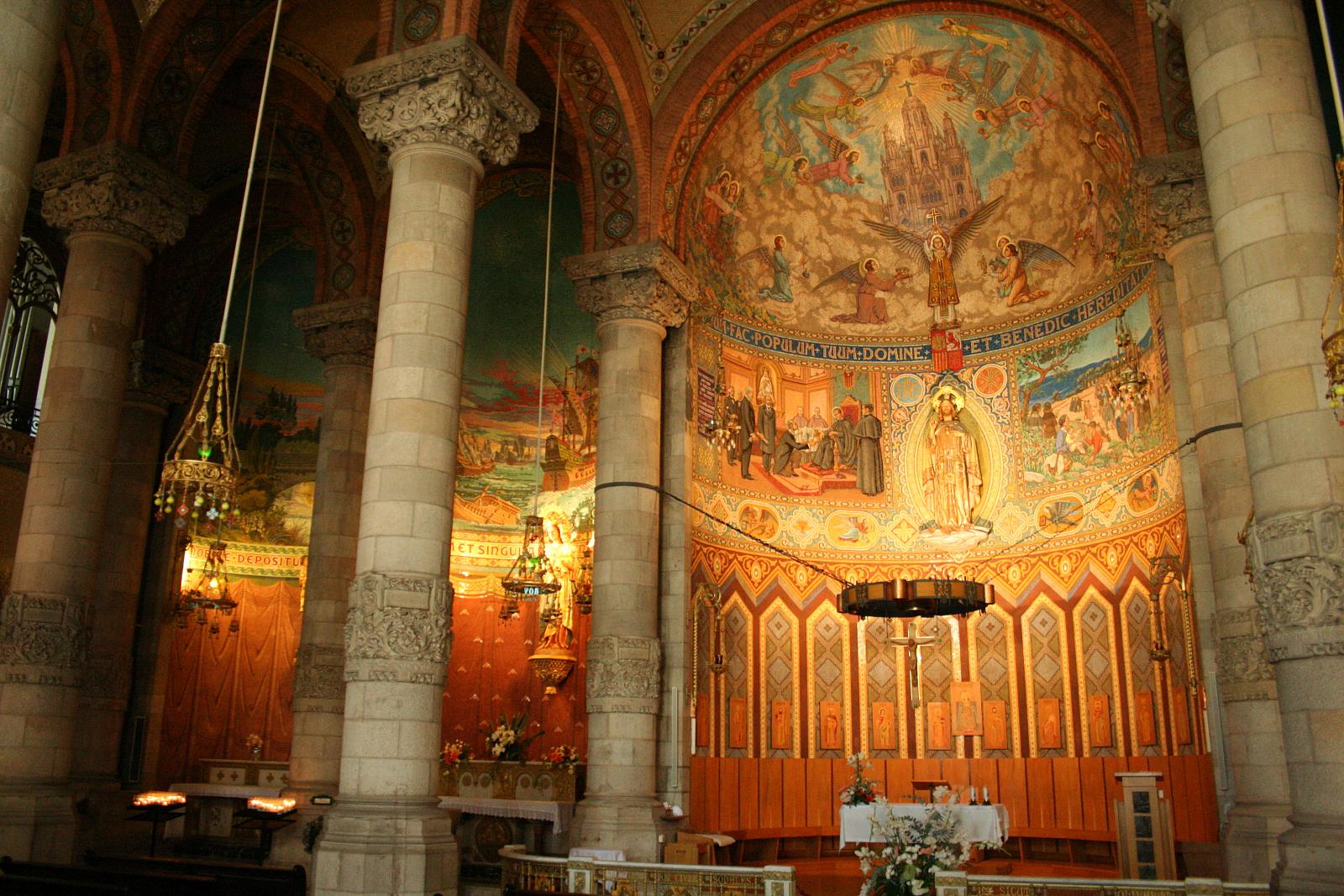
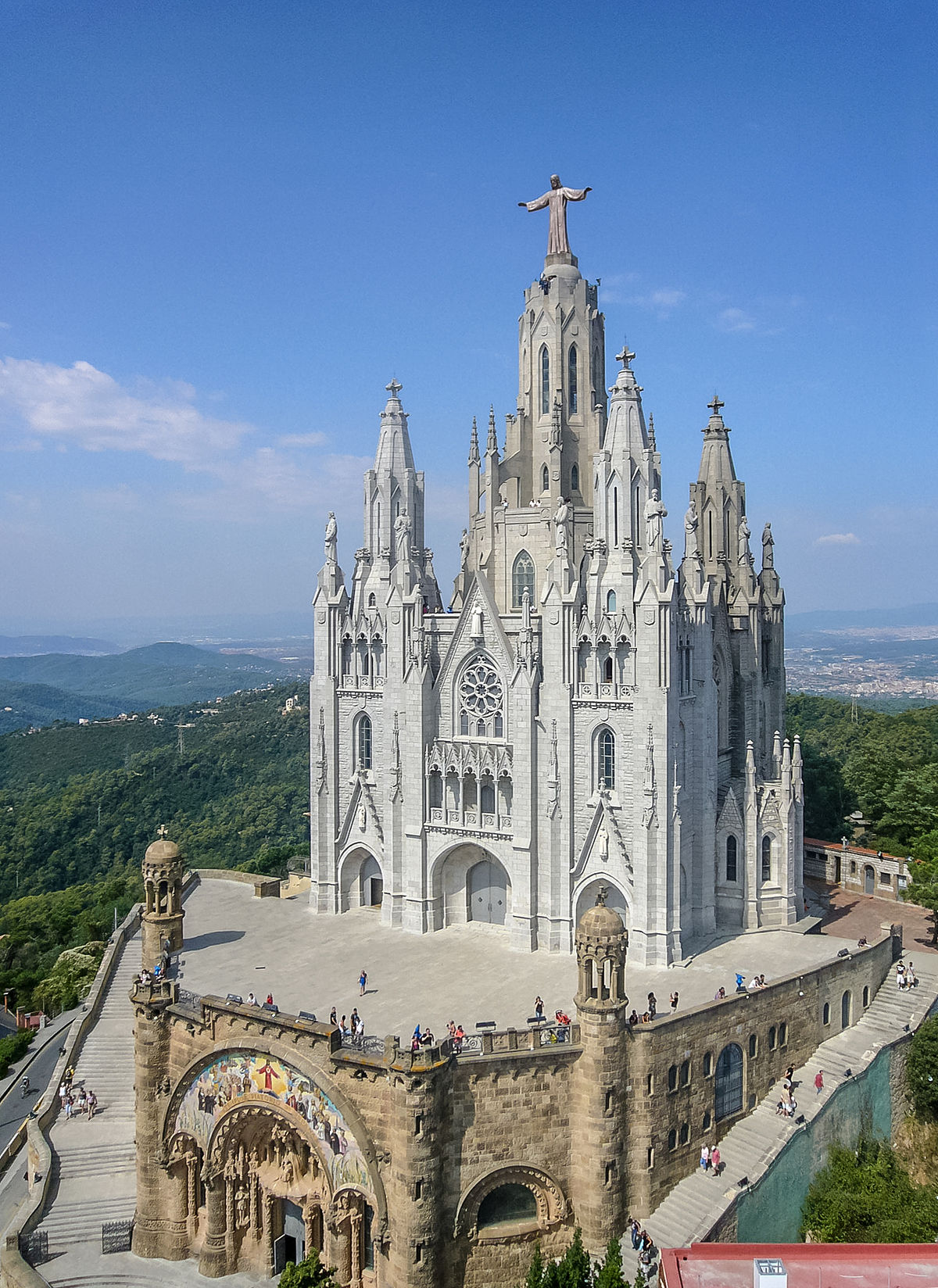
The interior is divided into a nave and two aisles with semicircular apses, with stained glasses and four rose windows on the facades. In the main altar stands the great crucifix, a work by Joan Puigdollers. The windows of the presbytery are dedicated to Pius X, John the Evangelist, Marguerite Marie Alacoque, Paul the Apostle and John Bosco.
The windows of the four towers contain the Latin phrase tibi dabo ("I'll give you"), the name of the mountain. At the level of the choir include founding saints: Marcellin Champagnat and Jean-Baptiste de La Salle on both sides of the presbytery, and Anthony Mary Claret, Joseph Calasanctius, John Bosco and Maria Domenica Mazzarello next to the main facade. The windows of the four facades are dedicated to Francis de Sales, Pius XI, Ignatius of Loyola, Francisco Javier, Pius IX, Rose of Lima, Leo XIII and Pius XII. The eight stained glasses of the dome depict scenes from the life of Jesus.
 3
Like
Published at 8:58 PM Comments (0)
3
Like
Published at 8:58 PM Comments (0)
The World's Most Expensive Bread
Tuesday, March 2, 2021
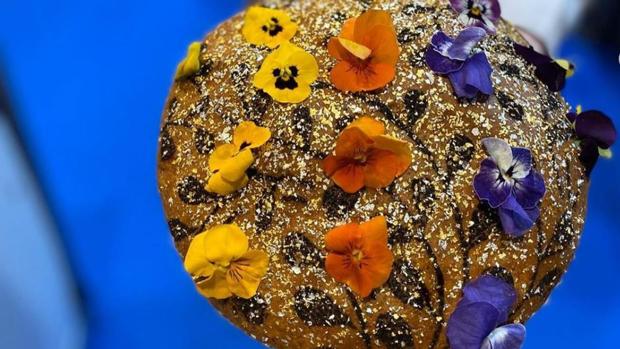 This bread is not a popular unleavened bread, but it is unique. The loaf weighs 400 grams and costs a mere 1,480 euros! It is the most expensive bread in the world. Many will wonder: What is it made of? Of gold? Well, they've hit the nail on the head. The precious metal, in its edible form and in three formats: powder, flakes and pieces, is one of the bread's main ingredients. This bread is not a popular unleavened bread, but it is unique. The loaf weighs 400 grams and costs a mere 1,480 euros! It is the most expensive bread in the world. Many will wonder: What is it made of? Of gold? Well, they've hit the nail on the head. The precious metal, in its edible form and in three formats: powder, flakes and pieces, is one of the bread's main ingredients.
The hands that knead this 'delicacy', not suitable for all palates, are those of Juan Manuel Moreno. It has been 13 years since he, along with his wife, took over the family bakery, a business of several generations about to close. Located in Algatocín, a town in the Malaga mountains of just over 700 inhabitants, this small business has become the production centre for one of the most exclusive products on the planet.
"Making this bread costs me between 900 and 1,000 euros," explains the master craftsman who ensures that he uses the best ingredients. Selected flour, salt extracted by hand from the rock, gold, silver, roasted malt, more importantly, the local water. "It is hard water, of extraordinary quality," he points out. That, and a lot of time. Between 12 and 18 hours, are invested in the preparation. "It needs a long fermentation to be healthier, unlike industrial bread that seeks to produce the largest amount in the shortest time," he recalls.
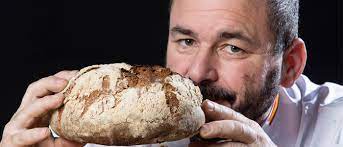
Despite its high price, the sales of this bread have not been affected by the pandemic. "We released it in February 2020 and since then we have sold 96 units". Almost a hundred pieces that, at a rate of 1,480 euros each, add up to a whopping 142,000 euros.... for bread.
It is clear that consuming bread at almost 1,500 euros is within the reach of very few. His clients, says the baker, seek "glamour and exclusivity." Among them, Arab sheikhs and Russian and Chinese businessmen, in that order.
"They buy it to compete with each other," says the creator of this bread, trying to explain its success, despite the high cost. Without revealing the identity of his clients, he acknowledges that his product has been to weddings of Arab princes or Russian banquets. "They even left us, on one occasion, a tip of 500 euros," he confesses. Also noteworthy is the case of a retiree, from Alhaurín de la Torre (Málaga), who commissioned a piece for the simple whim of trying it. "He told me that he did not want to die without eating a piece of gold," says the businessman.
Beyond its exclusive products, the pandemic does not seem to have made a dent in the business, which has 170 varieties of bread (mostly quite affordable) and has doubled its sales, despite the closure of the hospitality industry. "People continue to consume bread at home," says Juan Manuel, who has a portfolio of 400 clients in Spain and which he maintains thanks to online sales, gourmet shops and herbalists. "The daily turnover at the beginning of 2020 was 1,800 euros and, at the end of the year, we reached 3,000," says the businessman who is confident that this upward evolution will continue.
The next project is to install a factory on some land that they have bought in Marbella, a strategic area due to its high purchasing power. In this way, they will increase the workforce, which currently numbers 10 people and will continue to expand their business. A success baked with work, effort and ingenuity. And a lot of love for bread.
https://www.tupanadero.es/inicio/
 1
Like
Published at 9:10 PM Comments (0)
1
Like
Published at 9:10 PM Comments (0)
Spam post or Abuse? Please let us know
|
|